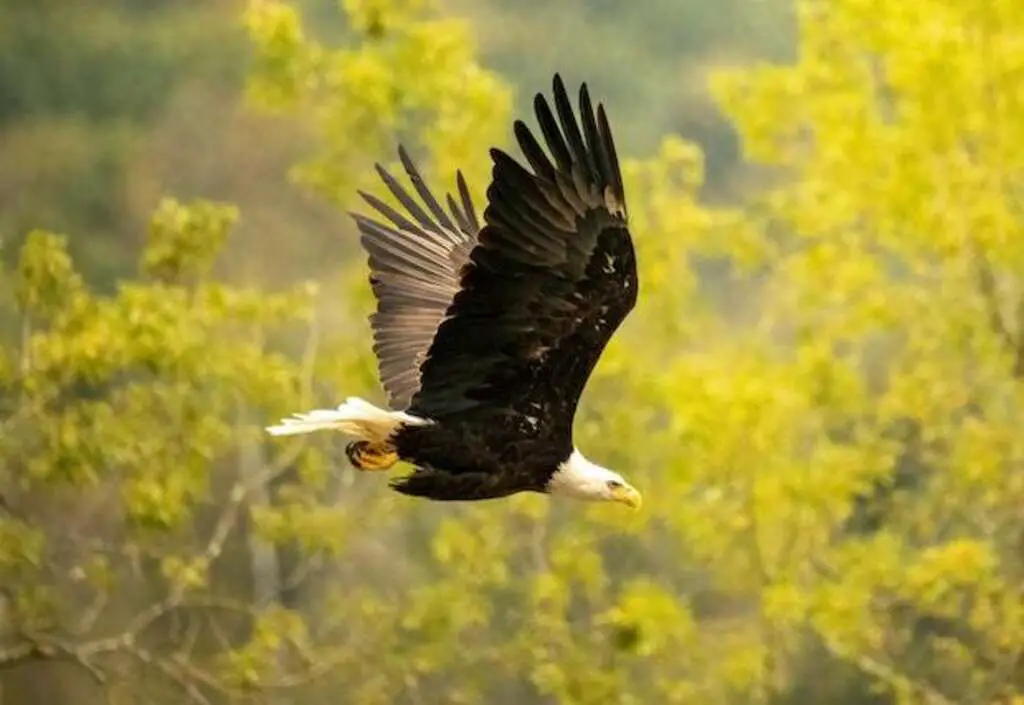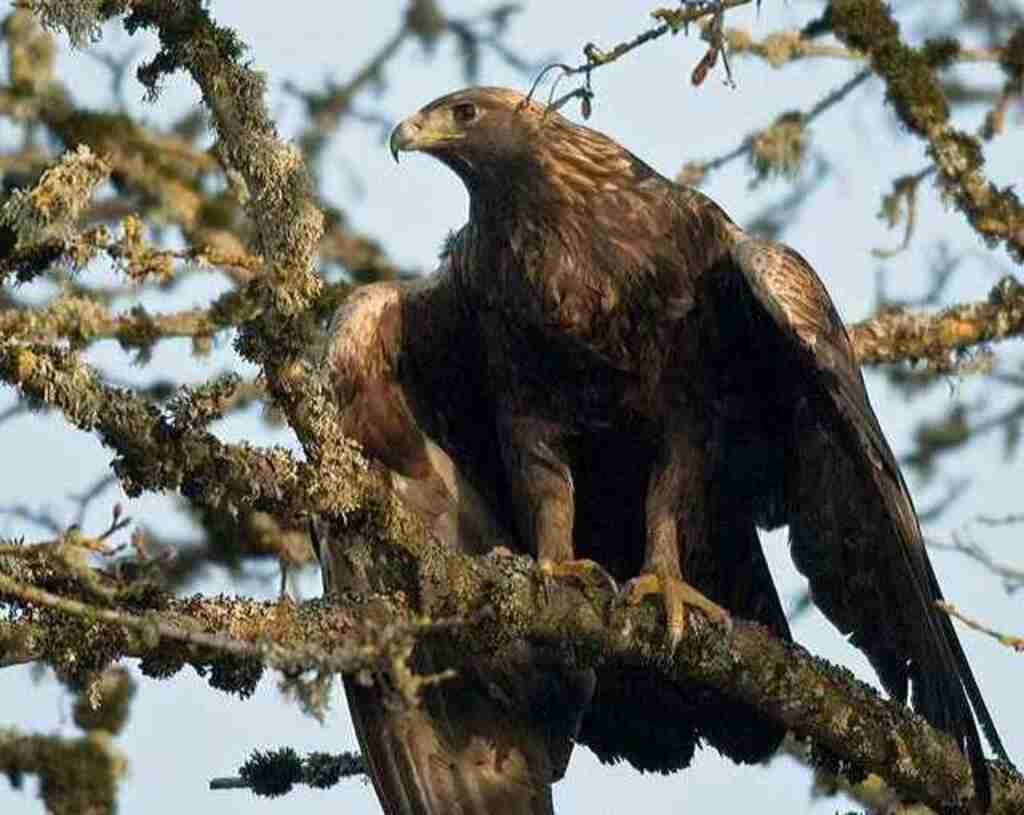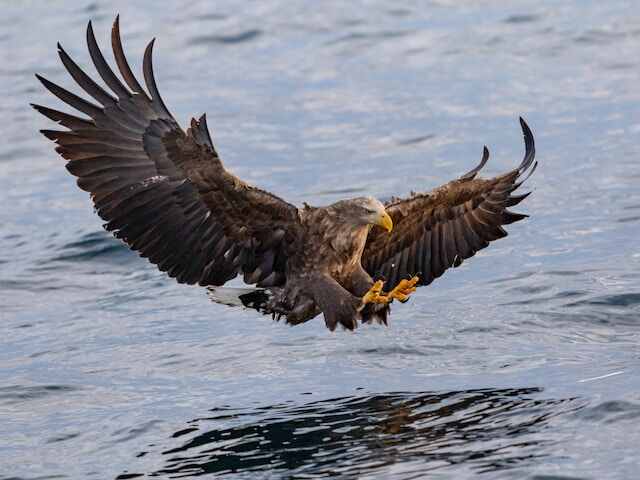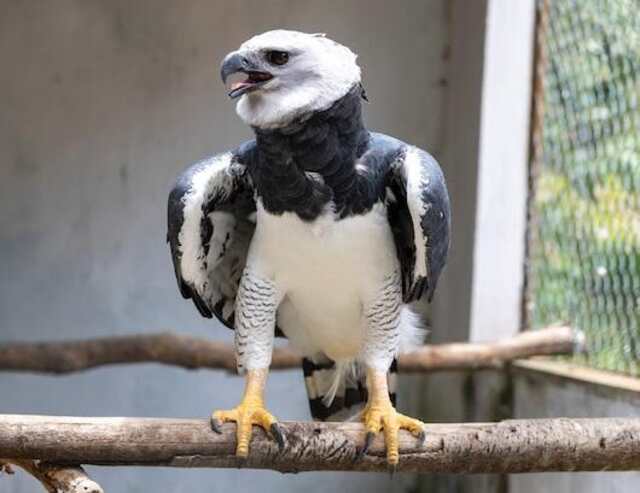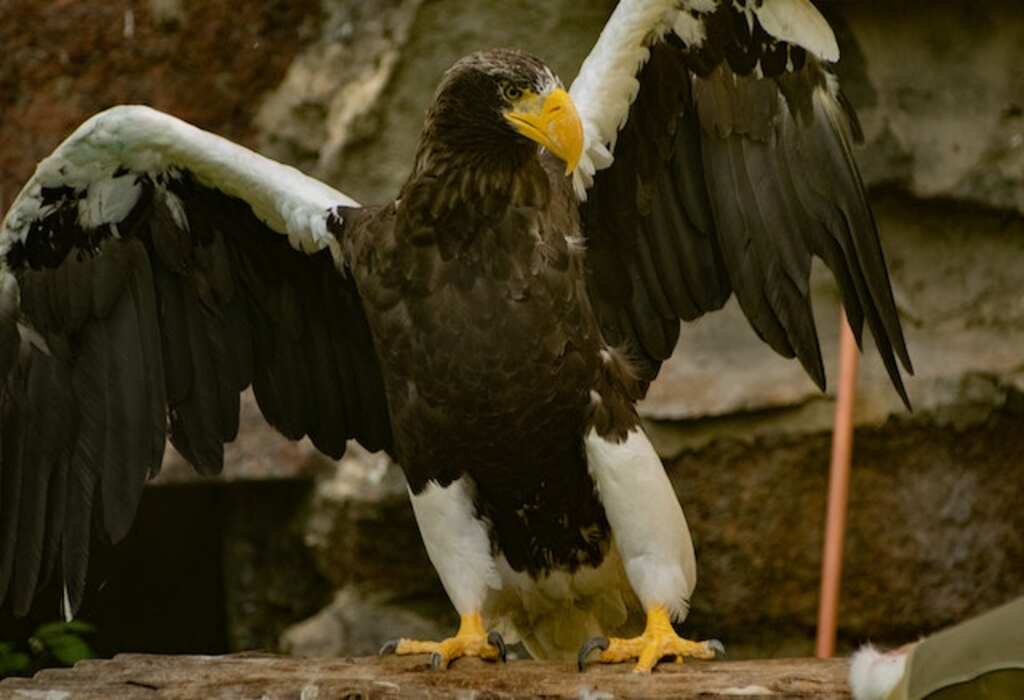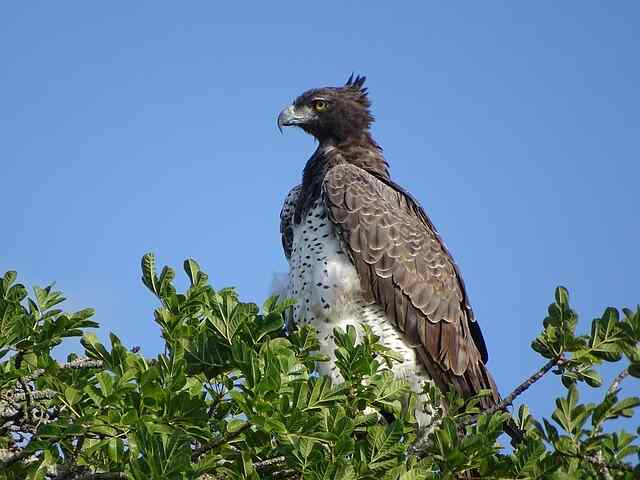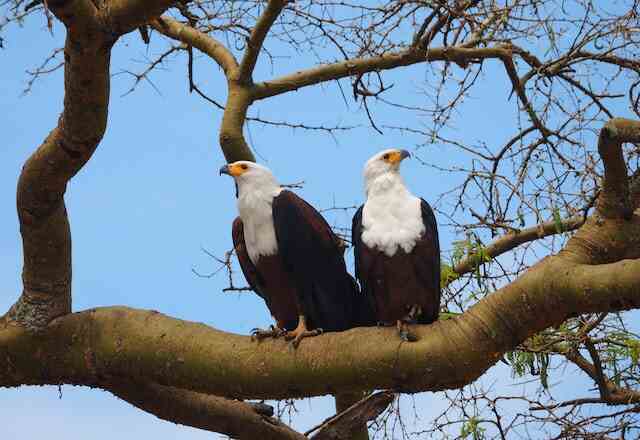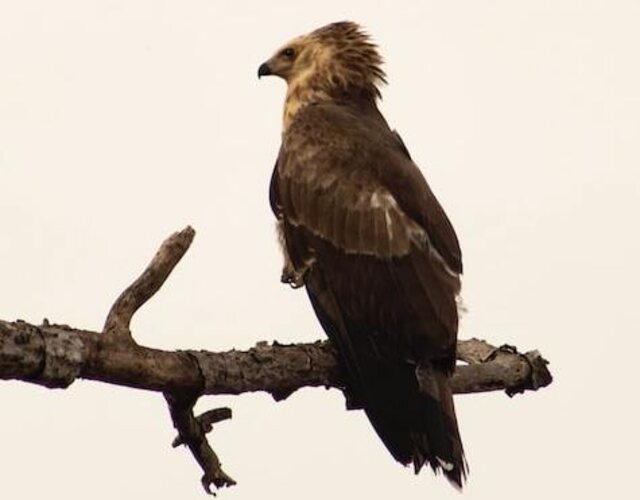In the vast expanse of the sky, where the sun’s golden rays illuminate the world below, majestic creatures soar with grace and power. Eagles, with their impressive wingspans and razor-sharp talons, epitomize the essence of avian supremacy.
Among their many extraordinary qualities, their speed captivates the imagination and leaves us in awe.
In this article, we delve into the realm of these remarkable birds of prey to uncover the answer to a burning question: which eagle is the fastest?
As we embark on this journey, we must adopt the lens of objectivity, focusing on scientific facts and evidence.
From the Golden Eagle, a mighty hunter with impressive speed, to the White-tailed Eagle, a majestic bird of prey with surprising swiftness, we will explore each contender’s unique attributes.
Additionally, we will delve into the prowess of the Harpy Eagle, the Philippine Eagle, the Martial Eagle, the African Fish Eagle, and the Crowned Eagle, each with their own remarkable abilities.
Prepare to be transported to the realm of the skies, as we unveil the secrets of these magnificent creatures and crown the fastest eagle in the world.
Table of Contents
- 1 Key Takeaways
- 2 Which Eagle Is The Fastest
- 3 Introduction to Eagles and their Aerial Abilities
- 4 The Golden Eagle: A Mighty Hunter with Impressive Speed
- 5 The White-tailed Eagle: A Majestic Bird of Prey with Surprising Swiftness
- 6 The Harpy Eagle: A Powerful Predator with Remarkable Agility
- 7 The Philippine Eagle: A Critically Endangered Giant with Astounding Speed
- 8 The Steller’s Sea Eagle: A Magnificent Bird with Incredible Wing Power
- 9 The Bald Eagle: America’s National Symbol and a Skilled Hunter
- 10 The Martial Eagle: Africa’s Largest Eagle and a Ferocious Hunter
- 11 The African Fish Eagle: A Skilled Fisherman with Impressive Speed
- 12 The Crowned Eagle: A Stealthy Hunter with Surprising Speed and Strength
- 13 Conclusion: Unveiling the Fastest Eagle in the World
- 14 Frequently Asked Questions
- 15 Author
Key Takeaways
- The Golden Eagle follows closely behind, with a maximum speed of 150-200 mph.
- The White-tailed Eagle has a maximum speed of 70-80 mph, making it slower than the Golden Eagle.
- The Harpy Eagle has a maximum speed of 50-55 mph, making it one of the slower eagles in terms of speed.
Which Eagle Is The Fastest
The fastest eagle is the Philippine Eagle, reaching speeds of up to 150 kilometers per hour (93 mph) during flight.
Its incredible speed allows it to swiftly maneuver through the dense forests of the Philippines in search of prey.
With its impressive wingspan and agile flight, the Philippine Eagle reigns as the undisputed champion of avian speed. 🦅💨
Introduction to Eagles and their Aerial Abilities
Eagles are renowned for their impressive aerial abilities, which enable them to soar through the skies with exceptional speed and grace.
These majestic birds play a crucial role in the ecosystem, as they are top predators and help maintain the balance of various populations in their habitats.
Eagle conservation efforts are therefore essential to safeguard the health of ecosystems they inhabit.
When it comes to their speed, eagles are known for their swift and efficient flight. For instance, the golden eagle, one of the largest and most powerful eagles, is a mighty hunter with impressive speed.
It can reach speeds of up to 150 miles per hour during its hunting dives, making it one of the fastest birds in the world.
This remarkable speed allows the golden eagle to swiftly catch its prey and survive in its challenging environment.
The Golden Eagle: A Mighty Hunter with Impressive Speed
Renowned for its exceptional hunting abilities and remarkable velocity, the Golden Eagle stands as an impressive aerial predator.
With a wingspan that can reach up to 7.5 feet, this majestic bird is well-equipped for its hunting techniques.
The Golden Eagle primarily resides in mountainous regions, open grasslands, and tundra habitats, where it can effectively spot its prey from a great distance.
This species feeds on a variety of small to medium-sized mammals, birds, and reptiles.
When hunting, the Golden Eagle relies on its incredible speed, which can reach up to 150 miles per hour during a stooping dive. Its sharp talons and powerful beak allow it to swiftly capture and kill its prey.
Transitioning to the subsequent section, the white-tailed eagle showcases similar agility and speed in its hunting prowess.
The White-tailed Eagle: A Majestic Bird of Prey with Surprising Swiftness
Symbolizing power and grace, the White-tailed Eagle soars through the skies with surprising swiftness, effortlessly navigating its environment in search of prey.
This majestic bird of prey showcases remarkable agility during its hunting endeavors. In flight, the White-tailed Eagle displays impressive swiftness, enabling it to cover vast distances while searching for food.
The agility of White-tailed Eagles in hunting is evident as they swiftly maneuver through the air, using their keen eyesight to spot potential prey from great heights.
They are known for their ability to dive at high speeds, reaching velocities of up to 40 miles per hour (64 kilometers per hour).
With their powerful wingspan and strong flight muscles, White-tailed Eagles can swiftly change direction, making them highly efficient hunters.
Transitioning to the subsequent section about the Harpy Eagle, we delve into another powerful predator with remarkable agility.
The Harpy Eagle: A Powerful Predator with Remarkable Agility
With its immense strength and astonishing agility, the Harpy Eagle is a formidable predator, effortlessly traversing dense rainforests in pursuit of its prey.
This species possesses unique physical characteristics that contribute to its remarkable hunting techniques.
The Harpy Eagle is known for its large, powerful talons, which can reach up to 5 inches in length, allowing it to snatch prey such as monkeys and sloths from the treetops.
Its broad wingspan, measuring up to 7 feet, enables it to maneuver swiftly through the forest canopy.
Additionally, the Harpy Eagle has keen eyesight, allowing it to spot prey from great distances. These adaptations make it a highly effective hunter in its native habitat.
Transitioning to the subsequent section about the Philippine Eagle, this critically endangered species showcases astounding speed in its pursuit of prey.
The Philippine Eagle: A Critically Endangered Giant with Astounding Speed
The Philippine Eagle, facing the threat of extinction, showcases remarkable speed in its pursuit of prey, darting through the dense rainforest like a lightning bolt piercing through the sky.
To fully appreciate the astonishing speed of this critically endangered giant, let us examine a comparison of the Philippine Eagle’s speed with that of other eagles:
| Eagle Species | Top Speed (mph) |
|---|---|
| Philippine Eagle | 40-50 |
| Harpy Eagle | 50 |
| Steller’s Sea Eagle | 40-50 |
The Philippine Eagle’s speed falls within the same range as the Steller’s Sea Eagle, another magnificent bird known for its incredible wing power.
However, unlike the Steller’s Sea Eagle, the Philippine Eagle faces numerous threats to its existence, including habitat loss and hunting.
To ensure the survival of this majestic creature, efforts must be made in endangered species conservation to protect its habitat and address the factors contributing to its decline.
Transitioning into the subsequent section, let us explore the remarkable attributes of the Steller’s Sea Eagle.
The Steller’s Sea Eagle: A Magnificent Bird with Incredible Wing Power
Exhibiting impressive strength and agility, the Steller’s Sea Eagle soars through the air with unparalleled grace, its broad wings slicing through the wind like a powerful vessel navigating turbulent waters.
This majestic and powerful predator possesses incredible wing power, enabling it to reach remarkable speeds. To further understand the Steller’s Sea Eagle’s prowess in the air, consider the following:
- Wingspan: With an average wingspan of 6 to 7.5 feet, the Steller’s Sea Eagle possesses long, sturdy wings that provide excellent lift and maneuverability.
- Speed: While there is no exact measurement of the Steller’s Sea Eagle’s top speed, it has been observed to reach speeds of up to 50 miles per hour during flight.
- Hunting technique: The Steller’s Sea Eagle uses its impressive speed and agility to hunt for fish, swooping down from great heights to snatch its prey from the water’s surface.
- Adaptations: This eagle’s large wings and powerful flight muscles allow it to cover vast distances, making it well-suited for its habitat in coastal areas and cold regions.
Transitioning to the next section about the bald eagle, we explore another remarkable eagle species with its own unique characteristics.
The Bald Eagle: America’s National Symbol and a Skilled Hunter
Boasting an iconic presence and unparalleled hunting abilities, the Bald Eagle commands attention as a symbol of American pride and a formidable predator.
This majestic bird, with a wingspan ranging from 6 to 7.5 feet, is known for its remarkable hunting skills. The Bald Eagle primarily preys on fish, using its sharp talons to snatch them from the water’s surface.
However, it is not limited to aquatic meals and is also capable of hunting small mammals and birds.
Compared to other eagle species, the Bald Eagle’s hunting techniques are impressive, showcasing its agility and precision.
It possesses exceptional eyesight, allowing it to spot prey from great distances. Moreover, its powerful wings enable swift and efficient flight, allowing it to chase its targets with remarkable speed.
Transitioning into the subsequent section about the martial eagle, another formidable hunter, we explore the African continent’s largest eagle and its ferocious hunting tactics.
The Martial Eagle: Africa’s Largest Eagle and a Ferocious Hunter
Renowned for its impressive size and fierce hunting prowess, the Martial Eagle of Africa commands awe as it dominates the skies.
With a wingspan that can reach up to 2.6 meters and a weight of up to 6.2 kilograms, this majestic bird is one of the largest eagles in the world.
Its size and strength allow it to take down prey that other birds would struggle to capture.
The Martial Eagle is known for its ferocious hunting techniques, which include swooping down from great heights and using its powerful talons to grasp and kill its prey.
This formidable predator primarily feeds on small to medium-sized mammals, such as hares and mongooses, but has also been known to take down small antelope.
Its speed and agility in flight make it a formidable hunter, capable of reaching speeds of up to 80 kilometers per hour.
The Martial Eagle’s hunting skills and dominance in the African skies make it a truly remarkable species.
Transitioning to the next section, the African Fish Eagle showcases its own impressive speed and fishing abilities.
The African Fish Eagle: A Skilled Fisherman with Impressive Speed
The African Fish Eagle is known for its exceptional fishing skills and impressive speed. When comparing the fishing techniques of the African Fish Eagle to the Bald Eagle, it becomes evident that the African Fish Eagle is more skilled in this aspect.
The African Fish Eagle has a unique hunting strategy, where it swoops down from its perch and uses its strong talons to snatch fish from the water’s surface. This technique requires precise timing and agility.
In contrast, the Bald Eagle primarily relies on scavenging or stealing prey from other birds.
Additionally, when comparing the African Fish Eagle to the Harpy Eagle, the latter is known for its exceptional agility and hunting strategies in the dense rainforest.
The African Fish Eagle, on the other hand, is adapted to hunting near bodies of water and relies on its impressive speed and precision.
Transitioning to the subsequent section, the Crowned Eagle possesses surprising speed and strength, making it a stealthy hunter in its own right.
The Crowned Eagle: A Stealthy Hunter with Surprising Speed and Strength
Contrary to expectations, the Crowned Eagle exhibits a remarkable combination of stealth, speed, and strength in its hunting tactics. This species of eagle is renowned for its ability to silently approach its prey, making it an incredibly effective hunter.
With its broad wingspan and powerful muscles, the Crowned Eagle can reach impressive speeds of up to 50 miles per hour (80 kilometers per hour) in pursuit of its prey.
Additionally, this eagle possesses exceptional strength, enabling it to capture and carry prey that is often larger and heavier than itself. Its strong legs and sharp talons make it a formidable predator in its habitat.
The Crowned Eagle’s surprising speed and strength allow it to thrive as a top predator in the ecosystem.
Transitioning into the conclusion, it becomes evident that the Crowned Eagle’s impressive hunting abilities make it a strong contender in the discussion of the fastest eagle in the world.
Conclusion: Unveiling the Fastest Eagle in the World
In conclusion, the Crowned Eagle’s remarkable combination of stealth, speed, and strength solidifies its position as a formidable predator in the ecosystem, showcasing its impressive hunting abilities.
To further understand its speed, it is essential to compare it to other birds of prey.
The table below provides a comprehensive comparison of the Crowned Eagle’s speed with that of other notable eagles and falcons:
| Eagle/Falcon | Maximum Speed (mph) |
|---|---|
| Crowned Eagle | 50-60 |
| Golden Eagle | 150-200 |
| Peregrine Falcon | 240-280 |
| White-tailed Eagle | 70-80 |
| Harpy Eagle | 50-55 |
As demonstrated, while the Crowned Eagle’s speed is impressive, it falls short compared to the breathtaking speeds of the Peregrine Falcon and the Golden Eagle.
However, it is important to note that the Crowned Eagle’s stealth and strength compensate for its slightly lower speed.
This combination enables it to successfully hunt and capture its prey, making it a formidable predator in its own right.
Frequently Asked Questions
How many different species of eagles are there in the world?
There are approximately 60 different species of eagles in the world. These majestic birds inhabit various habitats, from mountains to forests, and have been the focus of significant conservation efforts to protect their populations and preserve their habitats.
What is the average wingspan of an eagle?
The average wingspan of an eagle is approximately 6 to 7 feet. Eagle hunting techniques and unique adaptations of their wings, such as large surface area and strong flight muscles, contribute to their impressive wing span.
How do eagles catch their prey in mid-air?
Eagles employ various hunting techniques and prey selection strategies in mid-air. They swoop down from great heights, using their keen eyesight and powerful talons to snatch their prey. These tactics reflect their adaptability and predatory prowess.
What are the main threats to the survival of eagles in the wild?
Habitat loss and illegal hunting are the main threats to the survival of eagles in the wild. These factors lead to population declines and can disrupt their ecological balance, making conservation efforts crucial.
How long do eagles typically live in the wild?
The average lifespan of eagles in the wild is typically around 20 to 30 years. Various factors can affect eagle lifespan, such as predation, habitat loss, and availability of prey.

